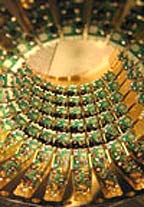
In February, a Vancouver, BC company launched what they call “the world’s first commercially viable quantum computer.” Where our current digital computers have bits of information that represent either 0’s or 1’s, quantum computers harness the mysterious laws of quantum physics to achieve “qubits” of information. Qubits, unlike bits, can represent more than one number at a time.
The science behind them is
very deep and intricate, unthought-of by the founders of our modern digital
computers. Quantum computers basically have the potential to make the fastest
computers we have today look like slugs.
There are some who doubt the possibility of a workable quantum computer, much
less one that is made for the markets of the world. The reason for the pessimism
lies with the aforementioned qubits of information. Each qubit must function in
a collective quantum state, so that any action performed on one simultaneously
affects all the others. Achieving this level of coherence is no easy task.
Human beings also live in a world in which each action we take has effects on
all the world’s other inhabitants. Achieving a practical consciousness of this
fact, acting as though we act not only for our own good, but also for the good
of all others, is not easy to achieve.
It requires a consciousness
of our interdependence as human beings and a willingness to act in ways that
optimize benefits for all and not just for a few. Because working for only a few
is, as quantum physics points out, unviable.